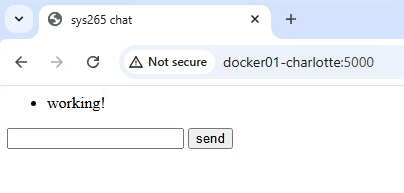| .. | ||
| app | ||
| docker-compose.yml | ||
| Dockerfile | ||
| README.md | ||
SYS265 - Mini Docker Project
flask web-chat app with docker
Note
I've been learning some network programming lately, so most of the python is my own. but I did use AI for the Dockerfile, some of the javascript, and general troubleshooting (netwoking in a Docker container can get confusing)
Project Structure
├── docker-chat
│ ├── app
│ │ ├── app.py
│ │ ├── requirements.txt
│ │ └── templates
│ │ └── index.html
│ ├── docker-compose.yml
│ └── Dockerfile
1. create app.py
this is the python/flask backend for the web app. it will open a websocket on port 5000 and handle message sent over it.
from flask import Flask, render_template
from flask_socketio import SocketIO, send
# initialize flask and socketio
app = Flask(__name__)
socketio = SocketIO(app)
# default page
@app.route('/')
def index():
return render_template('index.html')
# runs when message is received on socket
@socketio.on('message')
def handle_message(msg):
print("message: " + msg)
send(msg, broadcast=True)
# open websocket, listen on port 5000
if __name__ == '__main__':
socketio.run(app, host='0.0.0.0', port=5000, allow_unsafe_werkzeug=True)
2. create index.html
this is the html frontend for the web page, as well as some javascript to be a medium between network connections and the frontend webpage
<!DOCTYPE html>
<html>
<head>
<title>sys265 chat</title>
</head>
<body>
<ul id="messages"></ul>
<input id="message_input" type="text">
<button onclick="sendMessage()">send</button>
<!-- import javascript sockets.io library-->
<script src="https://cdn.socket.io/4.0.1/socket.io.min.js"></script>
<script>
// create websocket object
const socket = io()
// update html when a message is sent/received
socket.on('message', function(msg) {
let li = document.createElement('li');
li.textContent = msg;
document.getElementById('messages').appendChild(li);
});
// send message on socket when button is clicked
function sendMessage() {
const message = document.getElementById('message_input').value;
socket.send(message);
document.getElementById('message_input').value = '';
}
</script>
</body>
</html>
3. create requirements.txt
this includes necessary dependencies. they will be installed via Dockerfile
Flask==2.2.2
flask-socketio==5.3.2
werkzeug==2.2.2
4. create docker-compose.yml
this defines the services to be used. while this could work without the chat-net network, creating an isolated network made setting this up simpley imo, especially since we are already running wordpress.
version: '3.8'
services:
chat-server:
build: .
ports:
- "5000:5000"
volumes:
- ./app:/app
networks:
- chat-net
networks:
chat-net:
driver: bridge
5. create Dockerfile
# use this version of python
FROM python:3.12-slim
# create a working directory and copy requirements file to it
WORKDIR /app
COPY app/requirements.txt /app/requirements.txt
# install dependencies
RUN pip install --no-cache-dir -r requirements.txt
# copy the rest of the files to working directory
COPY app /app
# run the python script when the container starts
CMD ["python", "app.py"]
6. run docker-compose
cd docker-chat
docker-compose up -d
